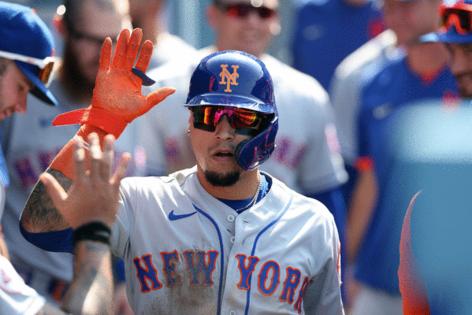How the MLB trade deadline has changed since the 2022 playoff expansion
Published in Baseball
NEW YORK — The MLB trade deadline is not what it used to be.
Since MLB expanded its playoff field to 12 in 2022, more teams have remained in contention deeper into the season.
Entering Tuesday, 22 of the 30 teams either held a playoff spot or were within 5.5 games of one. Sixteen teams had odds of 21.6% or better of making the postseason, according to FanGraphs metrics.
That has complicated the deadline, as fewer teams are incentivized to sell if they believe they have a chance of making the playoffs.
“It’s still early,” Yankees general manager Brian Cashman said on July 9, about three weeks before the July 31 trade deadline. “Teams are sharing information. I’ve had a lot of engagement about our needs, their needs and expressing interest here and there, and stuff like that. I can’t definitely say it’s going to be a weak trade market.”
In today’s era of analytics, many consider the postseason to be a crapshoot and that anything can happen once a team gets in. More avenues to make the playoffs should, in theory, make more teams buyers, but that in turn means there are fewer sellers to buy from.
So what does that mean for the deadline?
In the three years since the playoffs expanded, teams have remained active on the trade market.
In 2022, there were 39 trades in the final three days that teams could make them, according to Baseball Reference’s transactions history.
In 2023, there were 35 trades in the same time frame.
Last year, there were 46 trades, including 32 on deadline day.
Those totals are actually up a bit on average from the years that preceded the playoff expansion, not including the COVID-shorted 2020 season.
In 2021, there were 40 trades in the final three days.
In 2019, there were 30.
Any year before that is not as apt of a comparison, considering MLB eliminated the waiver trade deadline — which allowed teams to make deals until Aug. 31, even after the traditional trade deadline had passed — in 2019.
The biggest difference since the playoff expansion is the magnitude of the trades that are taking place.
In 2019, a frontline ace in Zack Greinke (who was 10-4 with a 2.90 ERA) was traded by the Arizona Diamondbacks to the Houston Astros.
The Toronto Blue Jays sent Marcus Stroman (2.96 ERA) to the Mets, while Trevor Bauer (3.79 ERA) went from Cleveland to Cincinnati. Nick Castellanos (11 home runs, .790 OPS) went from the Detroit Tigers to the Chicago Cubs.
In 2021, the Los Angeles Dodgers acquired Max Scherzer (2.76 ERA, 147 strikeouts in 111 innings) and Trea Turner (18 homers and 21 steals) in a blockbuster trade with the Washington Nationals.
The Nats also shipped slugger Kyle Schwarber, who had 25 home runs, to the Boston Red Sox.
The Cubs, meanwhile, were full-blown sellers, trading Anthony Rizzo to the Yankees; Kris Bryant to the San Francisco Giants; and Javier Baez to the Mets. Chicago was 50-53 when it began the firesale and would have been 3.5 games out of a wild-card spot in today’s playoff format.
That trade aged poorly for the Mets, who parted with Pete Crow-Armstrong — then a 19-year-old prospect — before missing the playoffs and losing Baez in free agency that winter.
The Atlanta Braves, meanwhile, rebuilt their entire outfield that July, acquiring Joc Pederson, Jorge Soler, Eddie Rosario and Adam Duvall, all of whom contributed to their championship run.
The 2022 deadline did feature a historic megadeal, with the Nationals trading Juan Soto to the San Diego Padres for a prospect haul that included James Wood, Mackenzie Gore and C.J. Abrams.
That trade was unique, however, as Soto had declined an extension offer from the Nationals and was under team control through 2024, making him anything but a deadline rental.
Other trades before that deadline included Luis Castillo to the Seattle Mariners, Josh Hader to the Padres and Frankie Montas to the Yankees.
The 2023 deadline featured far fewer marquee trades.
The Mets sent a 39-year-old Scherzer to the Texas Rangers and a 40-year-old Justin Verlander to the Astros. It was the Rangers’ acquisition of Jordan Montgomery from the St. Louis Cardinals — an under-the-radar trade when it happened — that paid the biggest dividends in their title run.
Last year, the Yankees’ acquisition of Jazz Chisholm Jr. from the Miami Marlins represented the most consequential splash.
The Dodgers added Jack Flaherty, who helped them win the World Series.
Other deals of note were lower-key, including Yusei Kikuchi to the Astros; Zach Eflin to the Baltimore Orioles; Jesse Winker to the Mets; and Soler going back to the Braves.
Those deals show that improving on the margins can go a long way, but that there are only so many blockbusters to be made at a given deadline.
Fewer blockbusters — coupled with more analytically driven front offices — means fewer premium prospects changing teams. Last year, not a single prospect within Baseball America’s top 100 was traded before the deadline.
The Diamondbacks’ direction will likely determine how fruitful this year’s deadline is, considering third baseman Eugenio Suarez and starters Zac Gallen and Merrill Kelly are among the potential prizes.
But Arizona entered Tuesday at 50-51 and only 5.5 games back of the National League’s third and final wild-card spot.
Other fringe contenders including the Cardinals, Minnesota Twins, Cleveland Guardians and Cincinnati Reds have similar decisions to make.
All of that will inform how this year’s deadline shakes out.
©2025 New York Daily News. Visit nydailynews.com. Distributed by Tribune Content Agency, LLC.







Comments